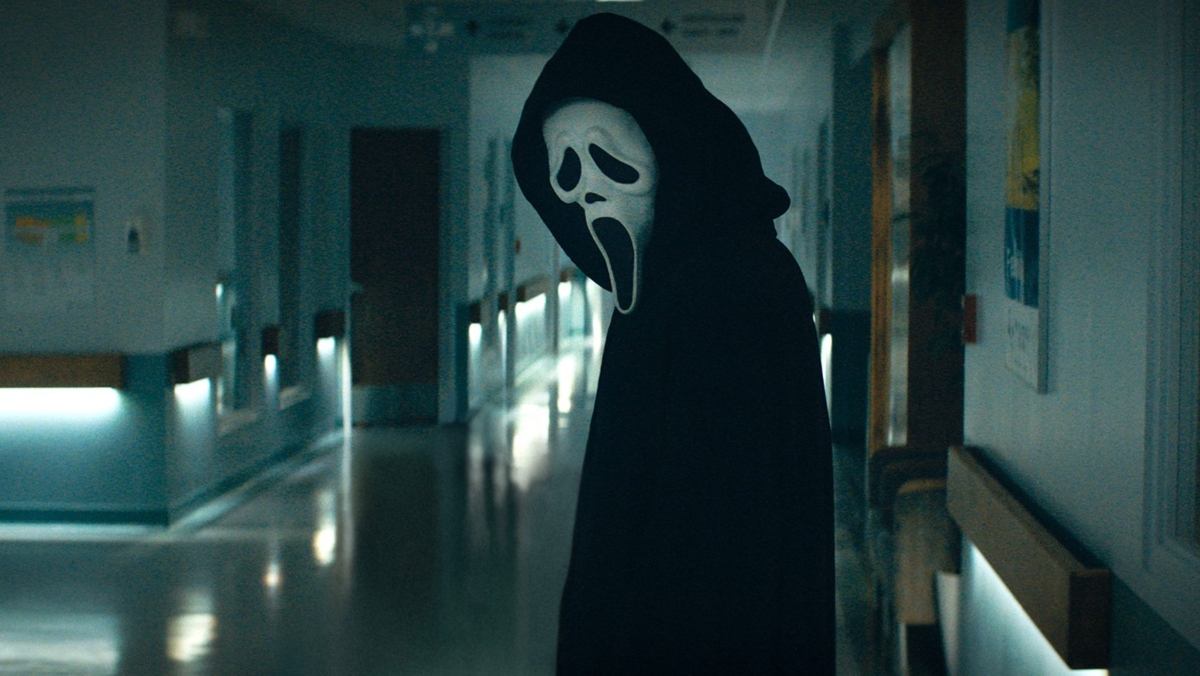
Not quite a reboot and not quite a sequel, SCREAM (2022) is the all but self-described “requel” to Wes Craven’s SCREAM franchise. The film strikes a near-perfect balance between old and new: retreading familiar territory with a contemporary feel. Though not a particularly immanent hazard in a series that thrives on irony and self-referentiality, the film avoids the sentimentality of many nostalgia-drenched reboots.

Fans of the SCREAM franchise know broadly what to expect from SCREAM (2022). The film opens 25 years after the original Woodsboro murders with highschooler Tara Carpenter (Jenna Ortega) answering a landline, playing horror trivia with the mysterious caller who quickly turns hostile, and surviving an attack by an intruder in a Ghostface mask. Tara’s sister, Sam Carpenter (Melissa Barrera), along with her boyfriend Richie (Jack Quaid) return to town to be with Tara in the hospital after hearing about the attack. A now retired and divorced Dewey Riley (David Arquette) reluctantly agrees to help solve the case, along with his ex-wife, the investigative journalist Gale Weathers (Courtney Cox), as well as Sidney Prescott (Neve Campell). The investigation ensues, complete with running meta-commentary, red herrings, and kills that feel gorier and more personal than previous installments of the SCREAM franchise.

The older cast members deliver excellent performances. David Arquette and Courtney Cox perfectly portray the distant tenderness of amicable divorcees, likely drawing from their own 2013 divorce. As we’ve come to expect from the previous four films, Neve Campell portrays a Sidney that absolutely kicks ass. But the “legacy” characters of the first four films primarily support new cast members. Jenna Ortega, Melissa Barrera, and Jack Quaid bring a new level of dramatic gravity to SCREAM with their performances. Ultimately, though, Mindy (Jasmin Savoy Brown), a descendant of the original film’s Randy and a horror enthusiast herself, steals the show along with Amber (Mikey Madison), Tara’s standoffish, protective friend.
SCREAM affords a certain permission to writers: permission to drop Easter eggs and tongue-in-cheek references throughout the script without strong narrative justification. James Vanderbilt and Guy Busick take maximum liberty here, with references not only to previous SCREAM films, the slasher genre, and horror in general, but also to other films like Rian Johnson’s THE LAST JEDI (2017) and KNIVES OUT (2019), as well as Tarantino’s ONCE UPON A TIME IN HOLLYWOOD (2019). Co-directors Matt Bettinelli-Olpin and Tyler Gillett offer a fairly restrained and straightforward approach, making choices that serve the film. It’s precisely what one would expect a modern SCREAM to look and feel like. SCREAM (2022) also contains perhaps not the best, but certainly the most unhinged (and my favorite) climax of any film in the series.
As in previous SCREAM films, there is a playfulness at work in the script and direction, like an extended scene of false jump-scares as Wes (named in honor of the late Wes Craven and played by Dylan Minnette) opens and shuts multiple cabinets in a row. That scene in particular captures something about SCREAM in general: it’s not quite a comedy, and it’s not quite a parody, but it nonetheless approaches and disrupts genre conventions with unsubtle humor. SCREAM’s lack of subtlety may be a turn-off for some, but for others (like myself), it’s exactly what we signed up for.




